Published
on 4
Jan 2004
|
All rights reserved.
|
|
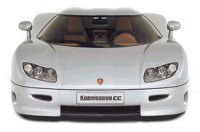 The
company The
company
Koenigsegg,
a
small Swedish
supercar maker, was founded by Christian von Koenigsegg in 1994. He was
very young, just 22 years old then, but he succeeded to raise the
required
money to develop and polish the supercar in the following 8 years until
the first CC8S delivered to client in March 2002. That’s amazing. His
biggest
success was to get the Swedish public excited (it’s the country’s first
supercar) and many Swedish component suppliers involved the project.
Even
Volvo and Saab gave helping hands to Koenigsegg in the evaluation of
aerodynamics
and chassis rigidity, all free of charge. Now I know why the company
could
survive for so long without earning a penny: it is simply a state-owned
project !
Since
the car
went into production,
6 cars were delivered. 25 others are on order book. Koenigsegg follows
the footprints of Pagani to be another new supercar maker succeeded to
survive, at least for the near future.
The
car
In the
UK,
CC8S
is priced
at £367,000, this make it more expensive than Porsche Carrera GT,
Pagani Zonda and Mercedes SLR, just shine of Ferrari Enzo. This seems
expensive
for a no-one-know supercar built in Sweden, but Koenigsegg claims very
tempting figures: 655 horsepower (that’s level with Enzo), 1275kg (90kg
lighter than Enzo), 0-60mph in 3.4 sec (0.15 sec faster) and a
McLaren-matching
240mph top speed. Christian von Koenigsegg also talked of possible
reaching
400kph (248.5mph). Can you believe that? obviously not before we
examine
its technical details.
 The
car was styled by Christian von Koenigsegg himself but its shape is
largely
dictated by aerodynamics. It is not as striking as Pagani or Enzo. At
some
angles it even looks bulky, like a big whale. But the whale delivers a
sense of power that you can’t find in its rivals either. The
car was styled by Christian von Koenigsegg himself but its shape is
largely
dictated by aerodynamics. It is not as striking as Pagani or Enzo. At
some
angles it even looks bulky, like a big whale. But the whale delivers a
sense of power that you can’t find in its rivals either.
Because
of the
targeted top
speed, the body is designed to be so smooth that it has a very low drag
coefficient of 0.30. This is much lower than Enzo (0.36), SLR (0.37)
and
Carrera GT (0.39). Unsurprisingly, the downside is a rather low
downforce,
just 50kg at the front and 70kg at the back. For comparison, an Enzo
generates
775kg while Pagani achieves 500kg.
The
chassis is
constructed
like other supercars. Central to it is a carbon-fiber tub (Koenigsegg
called
it "semi-monocoque") attached with steel subframe up front and aluminum
subframe at the rear for mounting engine, gearbox and suspensions.
Chassis
rigidity is 28,100Nm per degree despite of the targa roof. The whole
bodyshell
is also carbon-fiber. Koenigsegg claims a dry weight of 1175kg, which
translates
to 1275kg when fluid and fuel are loaded, i.e., what we usually refer
to
"kerb weight". In other words, CC8S is about as light as Pagani and
Saleen
S7, while being around 100 kilograms lighter than Enzo and Carrera
GT.
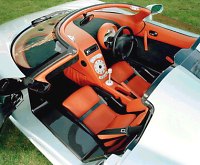 This
level of weight control is outstanding when you consider how well the
car
is built and equipped. In my recent Mercedes SLR report, I described it
"loaded with equipment cannot be dreamed in other supercars". That’s
not
exactly true, because the Koenigsegg also offers ABS, traction control,
air conditioning, climate control, CD changer, mobile phone, sat nav,
power
windows, power mirrors, central locking etc. The only thing it misses
is
an automatic transmission. This
level of weight control is outstanding when you consider how well the
car
is built and equipped. In my recent Mercedes SLR report, I described it
"loaded with equipment cannot be dreamed in other supercars". That’s
not
exactly true, because the Koenigsegg also offers ABS, traction control,
air conditioning, climate control, CD changer, mobile phone, sat nav,
power
windows, power mirrors, central locking etc. The only thing it misses
is
an automatic transmission.
Open
the door is
usually
a sensational moment for supercars, but this one is even more
spectacular:
unseen before, these doors operate with 2 axis, simultaneously pivot
upward
and outward. This might be meaningless to practicality, but it proves
that
the car is elegantly engineered. Step across the wide sills and drop
into
the carbon-fiber buckets. The environment is quite strange, because the
digital reading is housed in a strange instrument binnacle, the buttons
on center console are arranged like a telephone dial and the gear lever
is a foot long. While the taste of Koenigsegg is questionable, the
build
quality is not. This is a well finished interior. Most surfaces are
clad
with leather and the floor is bare carbon fiber. Space is quite limited
for people over 6 feet, but the seats and steering wheel are
multi-adjustable,
so finding a suitable driving position is easy.
Engine
and
Performance
Start
the
engine,
it roars
like an American V8. Yes, it is an American V8 ! very disappointing,
like
many cheaper British sports cars and American tuner’s cars, this
Swedish
supercar is powered by a supercharged version of Ford Mustang’s dohc
32-valve
V8. 60% of it has been modified, from the titanium header that lifts
capacity
to 4.7 litres, the lowered 8.6:1 compression, the intercooled Vortec
supercharger
which boosts 1.0 bar, the forged pistons and con-rods, the dry-sump
aluminum
crankcase that allows the engine to be installed lower in the chassis,
the weight-saving carbon-fiber intakes.... however, you still feel a
modified
Ford V8 is never an ideal engine to a supercar. It might work in Ford
GT,
but not a car costing 4 times the money. For sound, for willingness and
response, there is no replacement to a high-tech V12 or V10.
Unfortunately,
Koenigsegg could neither source a better engine nor develop a one
itself.
On
paper, this
engine delivers
655 horsepower at a high 6800rpm and it redlines at a mighty 7500rpm.
The
peak torque of 553 lbft arrives at 5000rpm. So, it should have the best
combination of power and torque on the market. Unfortunately, that is
only
on paper. In reality, the high-boost 4.7 V8, with its unusually high
specific
power, lacks torque at low to medium rev to fight against its rivals.
Its
torque curve is more like an old-fashion turbocharged engine’s than a
supercharged
engine’s, putting emphasis on the top end of its spectrum. At 3000rpm,
only half the maximum torque is available. In contrast, Mercedes SLR’s
supercharged V8 emits its peak 575 lbft at that rev. No wonder Autocar
magazine criticized it lack flexibility. It found the CC8S took a
laughable
10.2 seconds to accelerate from 50-70mph at top gear while Pagani Zonda
C12S needed only 4.4 sec.
 Much
of the blame must go to the Vortec supercharger. It is a
centrifugal-type
supercharger, unlike the screw-type supercharger used by other
supercars
such as Mercedes SLR, SL55AMG and Ford GT. Centrifugal-type
superchargers
are very much like turbochargers except that their turbines are driven
by crank instead of exhaust gas. Their advantage is high power gain,
which
the Koenigsegg needs to get most from its 4.7-litre capacity. The
disadvantage
is weak boost when the turbine is not spinning quick enough, just like
turbochargers. They also cause some throttle delay, similar to turbo
lag,
as Evo experienced in the Koenigsegg. Much
of the blame must go to the Vortec supercharger. It is a
centrifugal-type
supercharger, unlike the screw-type supercharger used by other
supercars
such as Mercedes SLR, SL55AMG and Ford GT. Centrifugal-type
superchargers
are very much like turbochargers except that their turbines are driven
by crank instead of exhaust gas. Their advantage is high power gain,
which
the Koenigsegg needs to get most from its 4.7-litre capacity. The
disadvantage
is weak boost when the turbine is not spinning quick enough, just like
turbochargers. They also cause some throttle delay, similar to turbo
lag,
as Evo experienced in the Koenigsegg.
However,
peaky
power delivery
is not all the problem. Autocar also suspected the engine is not as
powerful
as claimed. Theoretically, it should match or at least come close to
McLaren
F1 in acceleration, but the data recorded said otherwise: 0-60mph took
4.4 sec, 0-100mph in 8.4 sec, 0-150mph in 17.6 sec and 0-200mph in 35.4
sec. For comparison, McLaren did that in 3.2 sec, 6.3 sec, 12.8 sec and
28.0 sec respectively. This miss the mark by a large margin and falls
behind
other less powerful rivals.
What
about top
speed? Judging
from the time Autocar needed to get to 200mph, it is unquestionable the
car can pass the 210mph mark or maybe even 220mph. But so far
Koenigsegg
has yet to prove its McLaren-beating speed. It claimed once saw 233mph
when testing on a wet Nardo track and the car was still accelerating.
However,
you know, claim is claim. Before CC8S set a record in front of witness,
I won’t believe it could topple McLaren F1.
Handling
and
Ride
The
chassis of
Koenigsegg
is obviously much more promising than its engine. Weight distribution
between
front and rear axle is 45:55, this help it to balance remarkably well.
It is also fine-tuned by supercar tuning expert Loris Bicocchi, the man
responsible for the handling and ride of Bugatti EB110, Edonis and
Zonda.
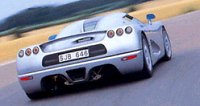 On
the road, the CC8S handles very good. Initially it feels too big and
wide
while understeer a little in tight corners. Give it an open road, it
immediately
comes alive. Up the pace and the understeer is replaced by neutrality.
Massive grip from the wide tires and powerful AP brakes (with superb
pedal
feel too) give you full confidence, as is the steering wheel which
transmits
stream of information from the front wheels to your arms. The Italian
Cima
gearbox also shifts satisfyingly, with short throw, slick and precise
action.
Bicochhi has the chassis and its human interface sorted so well ! On
the road, the CC8S handles very good. Initially it feels too big and
wide
while understeer a little in tight corners. Give it an open road, it
immediately
comes alive. Up the pace and the understeer is replaced by neutrality.
Massive grip from the wide tires and powerful AP brakes (with superb
pedal
feel too) give you full confidence, as is the steering wheel which
transmits
stream of information from the front wheels to your arms. The Italian
Cima
gearbox also shifts satisfyingly, with short throw, slick and precise
action.
Bicochhi has the chassis and its human interface sorted so well !
In fact,
this
chassis is
better sorted than Ferrari Enzo’s. Both cars have traction control to
prevent
from sliding rear wheels, but the Ferrari’s system works busier. In the
Koenigsegg, you have to steer aggressively to swing its rear end out.
That’s
partly due to its weaker torque, partly thanks to its better
balance.
It
also rides
pretty good
- not as supple as Zonda, but more forgiving than Enzo. Besides, the
aluminum
double-wishbones suspensions use electronic adjustable shock absorber
to
allow ride height adjustment. On bumpy roads, the driver can increase
ride
height to prevent bottom out.
Verdict
Like
other
supercars tuned
by Loris Bicocchi, Koenigsegg CC8S will be remembered for the way it
handles
and communicates with its driver. Unfortunately, it got a poor engine
and
therefore does not deliver the performance it promised and the
eagerness
its customers expected. Give it an AMG V12 and a more adventurous
styling,
it could jump to the top of the supercar chart.... but then it will
need
to be renamed to "Pagani". |
Verdict:    |
Published
on 20
May 2005
|
All rights reserved.
|
|
CCR
|
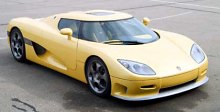 Feb
28, 2005 was an unbelievable day: Koenigsegg CCR broke the 7-year-old
top speed record held by McLaren F1. The swedish supercar lapped Fiat's
Nardo test track at 241.0 mph (387.9 kph), edging out the McLaren's
240.1 mph which was set in 1998. Feb
28, 2005 was an unbelievable day: Koenigsegg CCR broke the 7-year-old
top speed record held by McLaren F1. The swedish supercar lapped Fiat's
Nardo test track at 241.0 mph (387.9 kph), edging out the McLaren's
240.1 mph which was set in 1998.
If you look at the spec, you won't be surprised. The CCR is even more
powerful than the previous CC8S. Its supercharged 4.7-litre V8 is
boosted to 806 horsepower from 655 hp, and maximum torque surged from
553 lbft to 678 lbft. That made it the most powerful car in the world
until the arrival of Bugatti Veyron. Compare with McLaren F1, it
possesses 120 more horsepower and a slightly lower drag coefficient.
Breaking record is just a matter of time.
How can it achieve so much more power from the same engine capacity?
The answer is a twin-supercharger system. Instead of a single Vortec
supercharger, the CCR employs two smaller Rotrex superchargers. They
are not only more responsive – an aspect the CC8S is so weak – but also
raise maximum boost pressure from 1.0 bar to 1.4 bar. No wonder the CCR
can achieve an astonishing specific output of 171 horsepower per litre.
Again,
the superchargers are centrifugal type. They are extremely efficient at
high rev but relatively weak at low rev. They does not produce maximum
boost until 5000 rpm, thus the V8 produces max torque at a rather high
5700 rpm. Slow throttle response, or turbo lag, is another problem.
Koenigsegg partially solved this by introducing an innovative boost
control unit, whose vacuum-driven extra throttle feeds pressurized air
to the engine even before the turbine get working. It also creates a
low pressure zone before the turbine, helping it to accelerate more
quickly.
 Outside, the CCR is
distinguished from CC8S by reshaped headlamps and a large air splitter
at the nose. The latter helps
improving downforce and stabilizing the air under and around the car. Outside, the CCR is
distinguished from CC8S by reshaped headlamps and a large air splitter
at the nose. The latter helps
improving downforce and stabilizing the air under and around the car.
The brakes also got upgrade. Now it employs 362mm diameter discs and
6-piston calipers all round. Elsewhere the CCR remains the same as
CC8S. The total weight gain is just 5 kg.
Despite breaking the top speed record, company boss Christian von
Koenigsegg believes the CCR has potential to surpass 245.4 mph (395
kph) if it were tested on a straight test track instead of the
circular, banked Nardo. In fact, McLaren's 240.1 mph record was set on
Volkswagen's straight test track Ehra-Leissen. Previously, it did
“only” 231 mph at Nardo.
However, 2 months after the Koenigsegg test, Bugatti Veyron broke the
record again at 248.5 mph (400 kph). |
Verdict:     |
Published
on 1
Jul 2008
|
All rights reserved.
|
|
CCX, CCXR and Edition
|
|
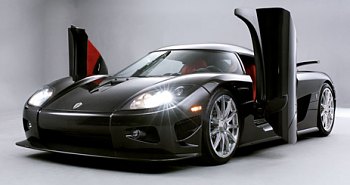
|
We could hardly imagine a supercar
which was first debuted in motor show 8 years ago and started
production 5 years ago could go stronger and stronger today...
|
Call
it a Scandinavian miracle won't be far from the truth. Koenigsegg has
surprised many, including myself, times to times. 5 years ago when I
saw the flawed CC8S, I thought this Swedish supercar maker might just
close down in a couple of years time due to lack of interest. Yes,
Christian von Koenigsegg sold only 6 units of CC8S in the first 2 or 3
years, but he kept investing into the company, hiring talents to
improve his cars and establishing partnerships with exotic component
suppliers all over the world. When his next car, CCR, broke the
long-standing speed record of McLaren F1 in 2005, orders started
flowing in. In another 2 years time, Koenigsegg built 20 CCR model to
satisfy the world's richest car enthusiasts.
More amazing is how well it resists the test of time. Supercars are
usually big toys to millionaires. They get popular in one instant and
turn outdated in the next instant. We could hardly imagine a supercar
which was first debuted in motor show 8 years ago and started
production 5 years ago could go stronger and stronger today. Koenigsegg
is just that magical. Thanks to relentless development, every iteration
of the Koenigsegg gets faster, better built and more desirable. If
there are any keys to its success, they must be the will and long-term
vision of Christian von Koenigsegg.
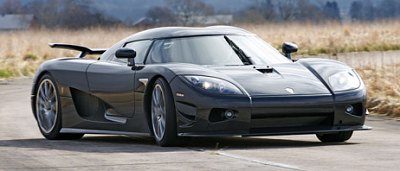
|
6 CCXR Edition will be built in 2008,
each possessing horsepower to beat Bugatti Veyron...
|
CCX
After CCR, Koenigsegg wanted to expand into the huge USA market.
Therefore in 2007 the CCR was superseded by the world-legal CCX. To
satisfy Federal impact regulations, its front and rear bumpers were
modified and lengthened. To satisfy American customers who ask for more
headroom, the bubble roof panel was raised by 50 mm. This resulted in a
slightly larger frontal area, while drag coefficient was also increased
from 0.30 to 0.32. The 4.7-liter V8 engine got a new block (no longer
based on Ford V8) which is lighter yet stronger. Power rating remains
unchanged from CCR, i.e. 806 horsepower and 678 lb-ft of torque, but it
can drink 91 Octane fuel now which is common in the US.
According to factory figures, Koenigsegg silently changed the 1280 kg
kerb weight to dry weight, which actually represents an increase of 100
kg. Interestingly, despite of a higher drag and more weight, it still
claims 245 mph top speed and 0-60 mph in 3.1 seconds. Considering the
CCR's 241 mph record was done at the banked Nardo, it is still possible
for CCX to do 245 mph on an arrow-straight test track. Nevertheless,
the 0-60 mph time claimed by Koenigsegg has always been nearly
impossible to achieve because it has problems to lay down that huge
power on the road, especially without a sophisticated launch control
like Ferrari's F1 Trac. That was why Sport Auto magazine managed only a
disappointing 3.7 seconds. At higher speed, the Koenigsegg started
catching up. By 186 mph (300 km/h) it is already noticeably faster than
Ferrari Enzo and trails only Bugatti Veyron (see table below).
|
0-100 km/h
|
0-200 km/h
|
0-300 km/h
|
Test source
|
Bugatti Veyron (2005)
|
2.5 sec
|
7.3 sec
|
16.8 sec
|
Bugatti
|
Koenigsegg CCX (2007)
|
3.8 sec
|
9.3 sec
|
21.9 sec
|
Sport Auto
|
McLaren F1 (1993)
|
3.2 sec
|
approx. 9.6 sec
|
approx. 22.4 sec
|
Autocar
|
| Pagani Zonda Cinque (2008) |
3.4 sec
|
9.6 sec
|
-
|
Pagani
|
| Ferrari Enzo (2002) |
3.6 sec
|
10.3 sec
|
26.1 sec
|
AMS
|
Mercedes SLR 722 (2007)
|
3.8 sec
|
10.5 sec
|
29.6 sec
|
Sport Auto
|
CCXR
The CCX is still slower than Bugatti Veyron, therefore Koenigsegg also
offered a bio-fuel version called CCXR to beat the Bugatti. Drinking
E85 fuel - i.e. a mixture of 85% ethanol and 15% petrol - allows higher
compression
ratio (8.8:1 instead of 8.2:1) and higher supercharger boost pressure
(1.6 bar instead of 1.4 bar), thus results in a Bugatti-beating 1018
horsepower ! Remember, this car is a massive 600 kg lighter than the
Bugatti, so despite of its traction problem and less low-down torque,
it might just match the Bugatti at higher speed.
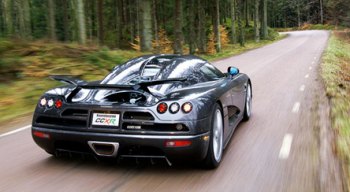
|
Excellent handling aside, ride is also
surprisingly supple...
|
CCX
Edition and CCXR Edition
In 2008, Koenigsegg uprated the cars again. Some 20 Edition models - 14
CCX Edition and 6 CCXR Edition - will be built during the year. They
are more track-oriented than the previous cars, with a larger front air
splitter, a spectacular "X-wing" rear spoiler (which generates 350 kg
downforce at 155 mph), stiffer and lower suspensions. The engines are
bored out to 4.8 liters, accompany with higher compression (8.6:1 and
9.2:1) and remapped ECU to produce higher output - the CCX Edition
pumps out 82 more horsepower while the bio-fuel CCXR Edition gains
slightly more torque. The big rear spoiler increases their drag
coefficient to 0.36, so the optimistic top speed claims - 250 mph for
CCX Edition and 254 mph for CCXR Edition - are based on cars with rear
spoiler removed.
As before, the Koenigsegg supercars are strong at handling. No matter
body control, grip, steering feel and accuracy it is always first
class. Its ride is also surprisingly supple, thanks to an immensely
rigid chassis (some 57,000 Nm per degree !) and lightweight suspensions
and wheels. What an engineering masterpiece it is. The fit and finish
of its carbon-fiber bodywork is also faultless, especially in the
Edition cars that unpainted pure carbon fiber is deliberately made
visible under a layer of lacquer. I still have some problems to accept
its cabin design - in particular that big round instrument pod and
dial-like center console - and the non-linear power delivery of its
twin-centrifugal supercharger V8. It will never provide the effortless
performance of Bugatti Veyron. However, neither will the Bugatti match
its raw fun.
No wonder Koenigsegg dares to ask for even higher prices than the
Bugatti. The CCX and CCXR Edition are priced at 1.33 million and 1.5
million Euro respectively excluding tax. All of them have been
allocated. What will Koenigsegg do next ? I can't wait. |
Verdict:     |
| Published
on 20
Mar 2014 |
All rights reserved.
|
|
Agera / Agera R
|
|
Koenigsegg has been
rivalling Bugatti to be the world's fastest car for many years but it
is still relatively mysterious. Few motoring journalists had the chance
to drive it. Most of them had their driving experience confined in
Koenigsegg's proving ground, i.e. a former airforce straight runway.
Fewer were given the freedom to drive it on public roads, let alone to
have a
long trip on challenging roads to find out its true talent. Moreover,
no one was allowed to put timing gears on, so until now all the
eye-popping performance figures were provided by the factory without
evidence. In September 2011, Koenigsegg invited Guiness to witness the
record runs of its new Agera R. The car hit 0-186 mph (300 km/h) in
14.53 seconds and 0-200 mph in 17.68 seconds, faster than Bugatti
Veyron SS. Despite that, we don't know if the test car was specially
prepared or tuned for the attempt, or if Guiness had the expertise to
verify it. Until Koenigsegg allows motoring journalists to test the
car independently, the debate about "which one is the world's fastest
road car" will continue…
Anyway, Agera is no doubt an insanely fast car, even faster than the
previous CCX Edition. It is a further evolution from the latter thus
its roots could be traced back to the CC8S that debuted some 12 years
ago. Many major
upgrades have been introduced in this generation so that Koenigsegg
claimed
it practically a new car. This
begins with the carbon-fiber tub chassis, which has its torsional
rigidity increased from the previous 57,000 to 65,000 Nm/degree. Note
that this is the rigidity of the tub only, not the whole chassis which
includes front and rear subframes made of chrome-moly steel. The rear
subframe
supplements the semi-stressed engine/transmission which is bolted
directly to the carbon-fiber tub. To improve ride comfort and
roadholding, the Agera introduces a unique rear suspension design
called
"Triplex". It links the left and right suspensions with an
additional spring and shock absorber so that it reacts softer to bumps
and harder to squat or vertical load (e.g. down force). The suspension
itself
remains passive (though ride height is adjustable), but ride quality
should be improved by using superlight carbon-fiber wheels (a world's
first for road cars). The front and rear wheels weigh 5.9 kg and 6.5
kg respectively, 2 kg and 3.2 kg lighter than the forged
alloy wheels of McLaren P1. Needless to say, its brakes are ceramic.
The powertrain is overhauled, too. Koenigsegg’s in-house V8 has its
displacement increased from 4.8 to 5.0 liters while the
twin-supercharger is replaced with twin-turbo. The engine still lacks
direct injection and variable valve timing, but a good knock control
and high-precision machining of the combustion chambers enable it to
run a pretty high, 9.0:1 compression ratio. Lightweight forged pistons
and titanium connecting rods allow the V8 to belie its undersquare
design (91.7 mm bore x 95.25 mm stroke) and spin up to 7500
rpm. Meanwhile, the turbos pump up to 1.4 bar of boost (same as McLaren
P1) into the combustion chambers, generating 960 horsepower and 811
pound-foot of torque. And that’s the regular Agera only. Like its
predecessor, the R version has modified fuel injection system to allow
drinking E85 or E100 biofuel. This pushes output to an astonishing 1140
hp and 885 lbft, very close to Bugatti SS, yet the Koenigsegg is 510 kg
lighter! The engine is also remarkably lightweight at 197 kg, thanks to
carbon-fiber intake manifolds and Inconel exhaust.
The Cima 7-speed gearbox is another new item. It is basically an
automated manual, but it incorporates an additional wet clutch-brake to
slow down the input shaft during upshifts. This speeds up rev-matching
hence gearshifts. Trickily, Koenigsegg calls it a dual-clutch
transmission. The Agera also gets a new active differential, which
unusually combines a conventional mechanical LSD with a supplementary
active
hydraulic clutch.
Outside, the carbon body keeps the same shape but its nose and tail
styling has been improved a little. It generates more down force – some
300 kg at 155 mph, thanks to the winglets mounted at the front radiator
outlets as well as the new adjustable rear wing. On the down side, drag
coefficient is worsened a bit to 0.33. This rises further to 0.37 when
the rear wing is set at high angle. Despite that, Koenigsegg continues
to be wild on estimation of top speed. It said the Agera R is
theoretically good for 273 mph (440 km/h), but this is possible only
when the factory unlocks its speed limiter, which is set at 233 mph
(375
km/h). Well, I suppose 233 mph is already more than any race tracks can
handle. This must be the least useful speed limiter ever made!
With a power-to-weight ratio trumping Le Mans cars, the Agera R feels
very fast for sure. At low rpm it might not be as punchy as Bugatti or
McLaren P1, as its large turbos take time to spool up, but once it
passes 4000 rpm the acceleration becomes really explosive, and the
surge is relentless until over 7000 rpm. Despite that, the rear axle
contains the power effectively, at least on the flat proving ground
where motoring journalists are allowed to exploit its performance. The
car also turns flatly and stops rapidly like a Le Mans race car. Our
only concern is whether it can carry over the excellent handling to
fast country roads, because its chassis tuning was done mainly on the
proving ground. Pagani Huayra is known for highly exploitable on
mountain roads. McLaren P1 and Porsche 918 are likely to be the same.
The Koenigsegg seems to be less tolerable and probably
edgier to push.
At cruising pace, however, the car displays a friendly manner. On the
undulating roads outside Koenigsegg’s factory, it rode with surprising
suppleness, thanks in no doubt to the low unsprung weight. The Cima
gearbox doesn’t upshift as smoothly as a real DCT, of course, but it is
quicker and slightly slicker than the AMTs of Huayra and Aventador. The
cockpit is roomy enough, and it is luxuriously trimmed to the extent of
flamboyant.
Whether it is worth US$1.5 million plus tax depends very much on your
taste. These days there are too many supercars to choose from, and all
are faster than you can imagine. The Koenigsegg is neither the most
technological advanced nor the most artistic, but it does feel special.
People buy it not only for its eye-popping performance figures but also
its countless of bespoke components and unique designs, not least of
which are the double-axis swivel doors.
|
Verdict:     |
| Published
on 18
Mar 2015 |
All rights reserved.
|
|
One:1
|
|
With the
introduction of Porsche 918, McLaren P1 and Ferrari LaFerrari, 2014 was
remembered as the year of hybrid supercars. Swedish supercar maker
Koenigsegg would join the hybrid battle a year later, but before that,
it has to push the boundary of conventional-powered supercars to an
unprecedented height, and that was realized by its One:1.
The One:1 is again an evolution from the breed of CC8 / CCR / CCX /
Agera, just made to be more advanced and extreme in every aspect. Only
6 cars (plus a prototype) were built and each commanded more than 2
million US dollars before tax. Koenigsegg calls it the world’s first
“megacar”, as it possesses 1 megawatt of power or 1360 DIN horsepower.
That trumps the current record holder Bugatti Veyron SS by 160 hp and
exceeds the last Agera R by 220 hp. More brilliant is that it manages
to cut 75 kg from the Agera at the same time, resulting in a DIN kerb
weight of 1360 kg. Yes, 1360 hp and 1360 kg, things could not have been
more coincidental! Thanks to this magic power-to-weight ratio, the car
is named One:1.
As usual, a few motoring journalists were invited to test the new
Koenigsegg at its proving ground, i.e. an ex-Swedish airforce runway,
while one was allowed to have a brief cruising at Goodwood festival of
speed.
Frankly, apart from some emotional expressions about its immense power,
speed and wheel spin, their reviews offered little insight. After all,
the car is simply too powerful to be assessed on unideal places like
those. Unfortunately, Koenigsegg would not allow outsiders to test the
car at race tracks or on decent roads. It expressed confidence to beat
the Nurburgring lap record of Porsche 918 – and said will do that later
– but it just wouldn’t allow third-party to do so. As long as
Koenigsegg keeps treating motoring journalists that way, I’m afraid we
cannot treat its cars and its more generous rivals on equal ground.
Anyway, to view the One:1 from technical perspective, it is undoubtedly
very interesting. It might even teach the big boys a few lessons. We
start from the aerodynamics. While it is obviously evolved from the
Agera, you will notice the extra winglets added fore of the front
wheels and the now aero-optimized door mirrors. More eye-catching is
the huge rear wing, which looks really like a whale tail. It is
double-plane and its angle is adjustable hydraulically, but most
special is the mounting means - it is mounted at the top surface by a
pair of carbon-fiber brackets extending a long way from the fastback.
What is the benefit of such an unusual arrangement? As the underside of
the wing is smooth and free of brackets, it allows a lot of air to flow
underneath the wing with little turbulence. This enhances the
aerodynamic efficiency, increasing downforce and adding little drag.
The car also incorporates active aero flaps at front and rear
underside. The result is 610 kg of downforce at 161 mph, almost double
the amount of Agera!
Admittedly, the One:1 is shaped to favour downforce more than its
predecessors (if you read the old reviews above, you will find there is
a continuous shift of priority from drag to downforce throughout the
years). The car has a slightly larger frontal area than the Agera, and
its drag coefficient is now said to vary from 0.45 to 0.50 depending on
the angles of aero devices. That sounds a lot for a modern road car.
For instance, Bugatti Veyron has its Cd ranges between 0.39 and 0.42,
while Porsche 918 is even down to 0.35. By calculation, the One:1 has
its total drag (CdA) exceeding the Agera R by nearly 40 percent (!).
Meanwhile, its engine power exceeds the latter by 19 percent.
Theoretically it should attain a lower top speed. Somehow, Koenigsegg
claims the same theoretical top speed of 273 mph… we can only say, no
matter 273 or 250, you have nowhere to verify it.
The Agera’s 5-liter twin-turbo V8 already ran a fairly high state of
tune. How does the One:1 find 220 extra horses? Koenigsegg altered a
lot of components actually, including cylinder heads, camshafts, valves
and fuel system, but more noticeable is a slight increase
(0.3 mm) of bore, which brings the capacity closer to 5.1 liters. Most
important, maximum turbo boost pressure is lifted from 1.4 to 1.8 bar,
which is extremely high (Bugatti SS and McLaren P1 employ 1.5 and 1.4
bar respectively). Now you might think of bad turbo lag. Brilliantly,
Koenigsegg avoids turbo lag by introducing a so-called “variable
geometry twin-turbo”. It does not employ conventional VTG technology
like Porsche 911 Turbo but an innovative variable-volume turbine
housing made by 3D printing. It goes without saying the design is
patented by Christian von Koenigsegg. (You can read more about it in AutoZine
Technical School) In short, it utilizes a small turbine housing for
faster spool up at low rev and a larger housing for optimized output at
high rev. You would not have expected a firm as small as Koenigsegg to
invent and build its own turbochargers!
Like Agera R, the maximum rating of 1360 hp is achieved with E85
biofuel. Its ECU can adapt to gasoline, but in that case power will
drop to 1180 hp. As before, the power curve of Koenigsegg is unusually
linear, more like a large naturally aspirated motor than a turbocharged
one. Its peak output is delivered at 7500 rpm, 400 higher than Agera R.
Maximum torque of 1011 lbft is not available until 6000 rpm.
The gearbox, a so-called “twin-clutch” 7-speed automated manual, is
carried over from the Agera. It's not known for smoothness but its
gearshift speed matches the performance of the car.
The chassis is basically the same as the Agera’s, as are the
all-round double-wishbone suspensions with "Triplex" rear damper.
However, the ride height, damping and
spring rates are now electronically adjustable through hydraulic
system, much like McLaren P1. Moreover, Koenigsegg has equipped the car
with GPS and 3G communication so that, when the car recognizes a race
track on which the factory had tested before, it will download the
factory data automatically and adjust the suspension setup for each
corner. No
wonder Koenigsegg dares to call it “active suspension”. Likewise, the
active aero, active differential and stability control can be adjusted
automatically to suit the particular track. It's a great idea, although
I suspect Koenigsegg has no time and resources to build up such
database.
Apart from active aero and suspension, the new Michelin Pilot Sport Cup
2 tires are another advance over the Agera, as they offer more grip and
better characteristics at the limit. Lastly but not least, the weight
saving also plays a part in better handling. There is no particularly
easy way to cut weight. Koenigsegg just trim weight bit by bit on many
components, from carbon-fiber coating to each bolt. The pursuit of
excellence is amazing.
With only 6 cars built and all delivered already, we are unlikely to
see the One:1 stack up against LaFerrari, P1 or 918 Spyder in
comparison test. I believe it could be extremely fast and stable on a
track. Its variable suspension may deliver reasonable or even good ride
comfort on normal roads. On the downside, its twin-turbo V8, despite of
jaw-dropping numbers, is tuned to linear delivery thus unlikely to
respond as quickly as those hybrid rivals. The gearshift should be more
brutal. Real-world handling could be handicapped by its 2-meter-plus
width and probably the lack of extensive testing on challenging roads.
Even so, the One:1 has a lot to admire for its engineering and
innovations – certainly more than the
headline numbers.
|
Verdict:     |
Published
on 8
Dec 2017
|
All rights reserved.
|
|
Agera RS
|
|
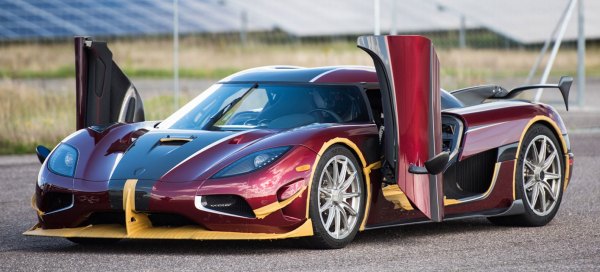
|
|
Initially
described as a track-focused model, the Agera RS actually offers more
usability than One:1.
|
|
Don’t
expect this article can give you the driving impression of Agera RS,
currently the fastest car in the world. Just like any Koenigseggs, it
is extremely exclusive, and neither its maker nor its buyers are
willing to let automotive journalists road test the car (other than a
leisure ride perhaps). However, it doesn’t matter, because the Agera RS
is very close to One:1, so it should drive similarly. In fact, since
the earliest CC8S launched 15 years ago, each iteration of Koenigsegg
is close to its predecessor. The line evolved continuously throughout
the years in a fashion that makes Porsche 991 look almost
revolutionary.
So what is Agera RS? You might remember Agera, the nameplate Koenigsegg
started using since 2011. Even then, it was already good for 1140
horsepower and 273 mph in biofuel form. The Agera remained to be the
“production” model of Koenigsegg, whereas One:1, created in 2014, was
an even faster and more exclusive offering, with only 6 cars built for
its very rich customers. The One:1 introduced some key improvements
such as aerodynamics (especially the trailing rear wing) and a heavily
modified V8 with new variable-volume turbos that produces 1360 hp on
E85 fuel. Its suspension became hydraulically adjustable and the setup
could be altered by GPS and 3G download. Moreover, it wore stickier
Michelin Cup 2 tires. After the completion of One:1, Koenigsegg applied
what it learnt back to the Agera, and the result is Agera RS.
When the Agera RS was introduced in Geneva motor show in 2015, it was
described as a track-focused model. Ridiculously, this car actually
offers more usability than the One:1, because it has a larger luggage
compartment (like other Ageras) which makes it possible to store the
removable roof panel. Besides, the deletion of roof-mounted air scoop
enables the return of a rear window, however small it is, so it has
better rearward visibility. Initially, the Agera RS was equipped with a
smaller, tail-mounted rear wing. Power remained 1180 hp on gasoline.
What it learnt from the One:1 were small details: aerodynamics (e.g.
front splitter, winglets and active flaps under the car), lightweight
sound insulation, the active self-leveling suspension, 3G-connected
chassis setup and Cup 2 tires. However, later cars were finished with a
trailing rear wing and the same 1MW engine as One:1. Again, 1360
horsepower is available only when drinking E85 fuel. As for kerbweight,
the car is quoted 1395 kg, just 35 kilos more than the One:1. A total
of 25 cars was planned to be built, and by this time all of them should
be already delivered.
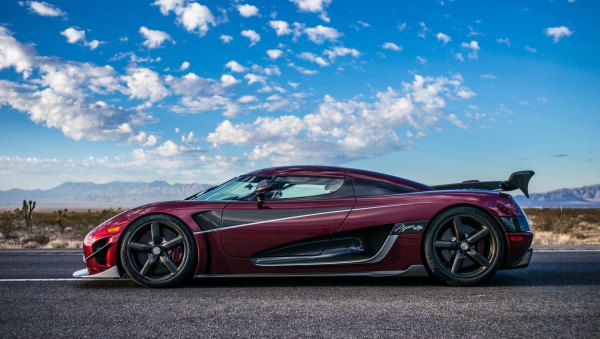 |
|
The
Agera RS set 277.9 mph 2-way average on a public highway!
|
|
Living under the shadow of One:1, the Agera RS was rather understated
until Koenigsegg used it for speed record attempts. In October 2017, it
smashed Bugatti Chiron’s record of 0-400km/h (249mph) in 26.88 sec, and
0-400km/h-0 in 36.44 sec on an airfield in Denmark (Bugatti did that in
41.92 sec). A month later, the same car set a land speed record of
277.9 mph in 2-way average on a closed section of Nevada’s Highway 160,
and by the way rewrote its own 0-400-0 record to 33.9 sec. Yes, on a
public highway! We used to think the 240 mph record of McLaren F1 could
hold forever. Then came the Bugatti Veyron with 253 mph and its
Supersport version with 268 mph. Now the bar is lifted to 278. Perhaps
300 mph is not a dream anymore. Who will be there first? Hennessey
Venom F5? Bugatti Chiron SS? Or yet another special Koenigsegg?
Christian von Koenigsegg must be thinking seriously.
|
Verdict:    
|
|